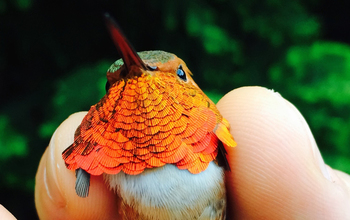Multimedia Gallery
Rufous hummingbird
Many species of western birds, such as this rufous hummingbird, are strongly associated with wetter environments. In a dryer future, such species could decline.
More about this image
A model by researchers at Oregon State University (OSU) analyzed how birds in western North America will respond to climate change and suggests that for most species, regional warming is not as likely to influence population trends as precipitation changes will.
"When we think of climate change, we automatically think warmer temperatures," said Matthew Betts, an ecologist in OSU's College of Forestry and principal investigator for this research. "But our analysis found that for many species, it is precipitation that most affects the long-term survival of many bird species. It makes sense when you think about it. Changes in precipitation can affect plant growth, soil moisture, water storage and insect abundance and distributions."
Betts and colleagues examined long-term data on bird distributions and abundance covering five states in the western U.S. and in the Canadian province of British Columbia. They tested statistical models to predict temporal changes in populations of 132 bird species over a 32-year period. They also examined the impact of temperature and precipitation on bird distributions at the beginning of the study period (in the 1970s) and then tested how well their predictions performed against actual population trends over the next 30 years.
Keying in on several variables, including possible changes during the wettest month in each region, the breeding season of different species, and the driest month by area, the researchers' model found that models including precipitation were most successful at predicting bird population trends.
"For some species, the model can predict about 80 percent of variation," said Betts, "and for some species, it's just a flip of the coin. But the strongest message is that precipitation is an important factor, and we should pay more attention to the implications of this moving forward."
The researchers chose December precipitation as one variable and found it to be influential in affecting bird populations because much of the critical precipitation is snow that falls in the winter and has a carryover effect for months later -- and the runoff is what affects stream flows, plant growth and insect abundance well down the road.
The researchers found the rufous hummingbird is one species that appeared affected by changes in December precipitation. The species is declining across western North America at a rate of about 3 percent a year, and the model suggests it is linked to an overall drying trend in the northwest. The evening grosbeak is similarly affected the authors say.
This research was funded in part by the National Science Foundation (grant PLR 09-41748).
To learn more about this research, see the OSU news story Precipitation, not warming temperatures, may be key in bird adaptation to climate change. (Date image taken: June 2014; date originally posted to NSF Multimedia Gallery: Aug. 25, 2017)
Credit: Sarah Frey, Oregon State University
Images and other media in the National Science Foundation Multimedia Gallery are available for use in print and electronic material by NSF employees, members of the media, university staff, teachers and the general public. All media in the gallery are intended for personal, educational and nonprofit/non-commercial use only.
Images credited to the National Science Foundation, a federal agency, are in the public domain. The images were created by employees of the United States Government as part of their official duties or prepared by contractors as "works for hire" for NSF. You may freely use NSF-credited images and, at your discretion, credit NSF with a "Courtesy: National Science Foundation" notation.
Additional information about general usage can be found in Conditions.
Also Available:
Download the high-resolution JPG version of the image. (754.1 KB)
Use your mouse to right-click (Mac users may need to Ctrl-click) the link above and choose the option that will save the file or target to your computer.



